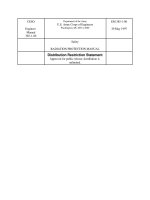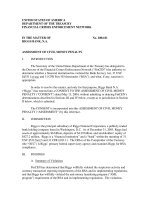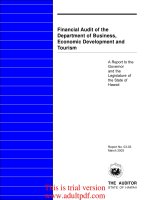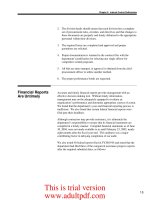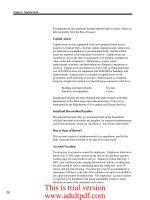REPORT NO. 2011-080 JANUARY 2011 DEPARTMENT OF THE LOTTERY Financial Audit _part3 doc
Bạn đang xem bản rút gọn của tài liệu. Xem và tải ngay bản đầy đủ của tài liệu tại đây (135.76 KB, 9 trang )
JANUARY 2011 REPORT NO. 2011-080
13
BASIC FINANCIAL STATEMENTS
DEPARTMENT OF THE LOTTERY
S
TATEMENT OF NET ASSETS
As of June 30, 2010, and June 30, 2009
(In Thousands)
Assets
June 30, 2010
June 30, 2009
Current Assets:
Cash and cash equivalents $156,313 $126,062
Interest receivable 468 549
Accounts receivable, net 16,473 43,185
Prepaid expenses 46 27
Inventories 1,021 843
Security deposits 2,444 2,729
Total Current Assets 176,765 173,395
Noncurrent Assets:
Restricted Assets
Cash and cash equivalents 99,419 50,590
Securities lending income receivable 292 631
Deposit with MUSL 9,336 3,073
Pending investment sales 2,816 0
Investments, grand prize 884,058 1,029,759
Investments, security lending collateral 749,137 842,681
Total Restricted Assets 1,745,058 1,926,734
Capital assets, net 1,421 1,235
Total Noncurrent Assets 1,746,479 1,927,969
Total Assets 1,923,244 2,101,364
Liabilities
Current Liabilities:
Accounts payable and accrued liabilities 13,686 8,407
Prizes payable 94,809 77,745
Due to Educational Enhancement Trust Fund 59,308 83,765
Deposits payable 2,450 2,736
Compensated absences payable 873 889
Total Current Liabilities 171,126 173,542
Current Liabilities Payable from Restricted Assets:
Securities lending fees payable 143 749
Obligations under securities lending 845,692 887,749
Grand prizes payable 172,589 194,955
Total Current Liabilities Payable from Restricted Assets 1,018,424 1,083,453
Noncurrent Liabilities:
Grand prizes payable from restricted assets 595,792 718,790
Compensated absences payable 2,804 2,942
Postemployment healthcare benefits payable 990 458
Total Noncurrent Liabilities 599,586 722,190
Total Liabilities 1,789,136 1,979,185
Net Assets
Invested in capital assets 1,421 1,235
Restricted net assets for undistributed appreciation on restricted investments 109,494 67,281
Restricted net assets for Restricted Prize Pool 0 32,661
Restricted net assets for MUSL 9,336 3,073
Restricted net assets for future prizes or special prize promotions 13,857 17,929
Total Net Assets $134,108 $122,179
See accompanying notes to financial statements.
This is trial version
www.adultpdf.com
JANUARY 2011 REPORT NO. 2011-080
14
D
EPARTMENT OF THE LOTTERY
S
TATEMENT OF REVENUES, EXPENSES, AND CHANGES IN NET ASSETS
Years ended June 30, 2010, and June 30, 2009
(In Thousands)
June 30, 2010 June 30, 2009
Operating Revenues:
Ticket sales $3,900,499 $3,938,037
Bad debt expense (1,075) (1,256)
On-line fees and miscellaneous 7,373 7,198
Retailer fees 226 210
Total Operating Revenues 3,907,023 3,944,189
Operating Expenses:
Prizes 2,346,162 2,340,372
Retailer commissions 216,207 220,548
Scratch-Off tickets 30,896 31,893
On-line games 27,390 27,982
Advertising 34,197 34,353
Personal services 27,045 26,857
Other contractual services 7,474 7,082
Materials and supplies 2,309 2,247
Depreciation 494 684
Total Operating Expenses 2,692,174 2,692,018
Operating Income 1,214,849 1,252,171
Nonoperating Revenues (Expenses):
Interest 6,057 7,133
Securities lending income 2,909 18,183
Securities lending fees (1,520) (8,980)
Investment management fees (364) (327)
Net appreciation (depreciation) in fair value of investments 90,875 46,832
Property disposition (loss) (4) (31)
Amortization of grand prizes payable (54,079) (64,757)
Total Nonoperating Revenues (Expenses), Net 43,874 (1,947)
Income Before Operating Transfers 1,258,723 1,250,224
Transfers to Educational Enhancement Trust Fund:
Transfers from revenue amd reserves (1,203,024) (1,241,015)
Transfers from unclaimed prizes (43,770) (46,840)
Total Transfers to Educational Enhancement Trust Fund (1,246,794) (1,287,855)
Change in Net Assets 11,929 (37,631)
Net Assets, Beginning of Year 122,179 159,810
Net Assets, End of Year $134,108 $122,179
See accompanying notes to financial statements.
This is trial version
www.adultpdf.com
JANUARY 2011 REPORT NO. 2011-080
15
D
EPARTMENT OF THE LOTTERY
S
TATEMENT OF CASH FLOWS
Years ended June 30, 2010, and June 30, 2009
(In Thousands)
June 30, 2010 June 30, 2009
Operating Activities:
Ticket sales 3,926,136$ 3,933,668$
Prizes paid to winners (2,335,361) (2,326,709)
Commissions paid and payments to retailers (216,207) (220,548)
Paid to vendors for goods and services (97,306) (107,442)
Paid to employees (26,545) (26,090)
Other operating revenue 7,599 7,408
Net Cash Provided by Operating Activities 1,258,316 1,260,287
Noncapital Financing Activities:
Payments to Educational Enhancement Trust Fund (1,271,251) (1,316,969)
Net Cash Used in Noncapital Financing Activities (1,271,251) (1,316,969)
Capital and Related Financing Activities:
Purchase of capital assets (684) (671)
Net Cash Used in Capital and Related Financing Activities (684) (671)
Investing Activities:
Cash received from maturity of grand prize investments 201,688 219,980
Cash paid to grand prizewinners upon maturity of grand prize investments (201,688) (219,980)
Security lending 85,466 0
Investment income, net of fees 7,233 16,626
Net Cash Provided by Investing Activities 92,699 16,626
Net Increase (Decrease) in Cash and Cash Equivalents 79,080 (40,727)
Cash and Cash Equivalents, Beginning of Year 176,652 217,379
Cash and Cash Equivalents, End of Year 255,732$ 176,652$
Reconciliation of Income from Operations to Net Cash Provided by Operating
Activities:
Income from operations 1,214,849$ 1,252,171$
Adjustments to reconcile income from operations to net cash provided by
operating activities:
Depreciation 494 684
Changes in assets and liabilities
(Increase) decrease in:
Accounts receivable 20,283 (5,180)
Inventories (178) 1
Prepaid expenses (19) (27)
Increase (decrease) in:
Allowance for uncollectible accounts 166 (1,006)
Accounts payable and accrued liabilities 5,278 (3,379)
Prizes payable 17,064 16,735
Compensated absences payable (153) 82
Postemployment healthcare benefits payable 532 206
Net Cash Provided by Operating Activities 1,258,316$ 1,260,287$
Noncash Investing, Capital and Financing Activities:
Increase/(decrease) in fair value of investments (31,456)$ (91,099)$
See accompanying notes to financial statements.
This is trial version
www.adultpdf.com
JANUARY 2011 REPORT NO. 2011-080
16
NOTES TO FINANCIAL STATEMENTS
DEPARTMENT OF THE LOTTERY
Years ended June 30, 2010, and June 30, 2009
1. SUMMARY OF SIGNIFICANT ACCOUNTING POLICIES
a. Reporting Entity
The State of Florida, Department of the Lottery (the Lottery) was established as a State agency with the
enactment of the Florida Public Education Lottery Act (the Act) in 1987. The purpose of the Act is “to
implement Section 15, Article X of the State Constitution in a manner that enables the people of the
State to benefit from significant additional moneys for education and also enables the people of the
State to play the best lottery games available.”
In evaluating the Lottery as a reporting entity, management has addressed all potential component units
for which the Lottery may be financially accountable and, as such, be includable in the Lottery’s
financial statements. The Lottery is financially accountable if it appoints a voting majority of the
organization’s governing board and (1) it is able to impose its will on the organization or (2) there is a
potential for the organization to provide specific financial benefit to or impose specific financial burden
on the Lottery. Additionally, the primary government is required to consider other organizations for
which the nature and significance of their relationship with the primary government is such that
exclusion would cause the reporting entity’s financial statements to be misleading or incomplete.
Management’s analysis has disclosed no component units that should be included in the Lottery’s
financial statements.
b. Basis of Presentation
The Lottery is accounted for as a proprietary type enterprise fund. Enterprise funds are used to account
for activities that are financed and operated in a manner similar to private business enterprises: (1)
where the costs of providing goods and services to the general public on a continuing basis are to be
financed through user charges; or (2) where the periodic determination of net income is considered
appropriate. The Lottery is reported as an enterprise fund within the State of Florida’s Comprehensive
Annual Financial Report.
c. Basis of Accounting
Basis of accounting refers to the timing of recognition of revenue and expenses in the accounts and
reporting in the financial statements. The financial statements are prepared on the accrual basis of
accounting in accordance with generally accepted accounting principles. Under this method, revenues
are recognized when they are earned and expenses are recognized when they are incurred.
The measurement focus of proprietary fund types is on a flow of economic resources method, which
emphasizes the determination of net income, financial position, and cash flows. All fund assets and
liabilities, current and noncurrent, are accounted for on the Statement of Net Assets. Under
Governmental Accounting Standards Board (GASB) Statement No. 20, Accounting and Financial Reporting
for Proprietary Funds and Other Governmental Entities That Use Proprietary Fund Accounting, proprietary funds
have the option to elect to apply all pronouncements of the Financial Accounting Standards Board
(FASB) issued after November 30, 1989. The Lottery has elected not to apply FASB pronouncements
issued after November 30, 1989, unless so directed by GASB.
This is trial version
www.adultpdf.com
JANUARY 2011 REPORT NO. 2011-080
17
The Lottery’s operating revenues and expenses generally result from the sale and marketing of Lottery
tickets and the payment of related prizes. All revenues and expenses not meeting this definition are
reported as nonoperating revenues and expenses.
d. Cash and Cash Equivalents
The Lottery considers all highly liquid investments with an original maturity of three months or less
when purchased to be cash equivalents. This includes cash in banks, repurchase agreements with
financial institutions, petty cash, balances held by the State Board of Administration (SBA), and pooled
investments in the State Treasury.
e. Investments
Florida Statutes authorize the Lottery to invest in certain instruments. The Lottery reports investments
at fair value. Investments that are not publicly quoted are priced by a third party through a discounted
cash flow method. Details of investments are included in Note 2.
f. Allowance for Doubtful Accounts
The allowance for doubtful accounts is based on an analysis of collectibility of accounts receivable,
which considers the age of the accounts.
g. Inventories
Supply inventory and promotional items are valued at cost, using the first-in, first-out method. Supply
inventory is comprised of game merchandise and prepaid postage.
h. Prepaid Expenses
Prepaid expenses represent warranty agreements paid for during the current year but which will not be
consumed or used up until a future period.
i. Capital Assets
Capital assets are stated at cost less accumulated depreciation. As required by Chapter 273, Florida
Statutes, a capitalization threshold of $1,000 and useful life extending beyond one year is employed for
tangible personal property. The Lottery’s capitalization threshold for intangible assets is $5,000.
Depreciation on all capital assets is computed using the straight-line method over the following
estimated useful lives:
Data processing equipment 3 to 5 years
Office furniture and fixtures 3 to 15 years
Vehicles and other equipment 3 to 20 years
Software 3 to 15 years
When capital assets are retired or otherwise disposed of, the costs and related accumulated depreciation
are removed from the accounts and any resulting gain or loss is reflected in the Statement of Revenues,
Expenses, and Changes in Net Assets, in the period of disposal. See Note 5 for more detailed
information on Capital Assets.
This is trial version
www.adultpdf.com
JANUARY 2011 REPORT NO. 2011-080
18
j. Net Assets
Net Assets includes categories for net investments in capital assets, restricted net assets for
undistributed appreciation on restricted investments, restricted net assets for future prizes or special
prize promotions, restricted net assets for the Restricted Prize Pool, and restricted net assets for MUSL.
See Note 6 for more information on MUSL.
The net investments in capital assets category represents the investment in capital assets, recorded at
cost less accumulated depreciation.
The restricted net assets for undistributed appreciation on restricted investments category represents the
undistributed appreciation for all restricted investment accounts.
The restricted net assets for future prizes or special prize promotions category represents the portion of
unclaimed prize obligations legally reverted back to the Lottery for the payment of future prize pools or
special prize promotions in accordance with Section 24.115(2), Florida Statutes.
The restricted net assets for Restricted Prize Pool category in the prior year represented the prize
expense reserved to support payments to winners of the Florida Lotto Plus jackpots in accordance with
Rule 53ER08-88, Florida Administrative Code, which was replaced by Rule 53ER09-54 Florida
Administrative Code. The requirement for this restriction ended with the elimination of LOTTO PLUS
in October of 2009.
The restricted net assets for MUSL category represents the amount placed into reserve for the Florida
Lottery by the MUSL Powerball Product Group in accordance with Rule 53ER09-52, Florida
Administrative Code.
k. Revenue Recognition
Lottery games are sold to the public by contracted retailers. Revenue is recognized when On-line tickets
are sold to players and when books of Scratch-Off tickets are settled. Certain games include tickets that
entitle the holder to exchange one ticket for another (free tickets). Such tickets are deemed to be
replacements and, therefore, are not included in ticket sales.
l. Commissions
Retailers receive a commission of five percent on ticket sales. The commission on ticket sales for
Scratch-Off games is based upon total tickets distributed to the players (including free tickets) which,
when compared to revenue, causes the percentage to be slightly higher than five percent. Additionally,
retailers are paid commissions through a one percent cashing bonus on redemption of tickets (including
free tickets).
m. Prizes
In accordance with the Act, variable percentages of the gross revenue from the sale of On-line and
Scratch-Off lottery tickets shall be returned to the public in the form of prizes paid by the Lottery or
retailers as authorized. Prior to July 1, 2006, the Act authorized, as nearly as practicable, at least fifty
percent of ticket sales must be returned to the public in the form of prizes.
Prize expense for On-line games is recorded based on prizes won by the players, as revenue is
recognized. Any prize that remains unclaimed at the end of a 180-day period following a draw is
considered unclaimed.
This is trial version
www.adultpdf.com
JANUARY 2011 REPORT NO. 2011-080
19
Prize expense for Scratch-Off games is recorded based on the predetermined prize structure for each
game, as revenue is recognized. Any prize that remains unclaimed 60 days after a Scratch-Off game is
closed is considered unclaimed.
Beginning July 1, 2005, 80 percent of all unclaimed prize money is deposited in the Educational
Enhancement Trust Fund (EETF). The remaining 20 percent of unclaimed prize money is added to the
pool from which future prizes are to be awarded or used for special prize promotions and is reported as
restricted net assets for future prizes or special prize promotions
All prizes are recorded at the actual amount except for the annuity-funded prizes, which are paid out on
a deferred basis. The actual prize expense for these types of prizes is based on the present value of an
annuity using the interest yield on the investments, which were acquired to fund the annuity.
n. Compensated Absences
Employees earn the right to be compensated during absences for vacation, illness, and unused special
compensatory leave earned for hours worked on legal holidays. Compensated absences for annual leave
are recorded as a liability when the benefits are earned. Compensated absences for sick leave are
calculated based on the vesting method. Within the limits established by law or rule, unused leave
benefits are paid to employees upon separation from State service. The cost of vacation and calculated
sick leave benefits is accrued in the period in which earned. The compensated absences amounts are
based on current year-end salary rates and include employer social security and pension contributions at
current rates.
o. Self-Insurance
The Lottery participates in the various self-insurance programs established by the State of Florida for
property and casualty losses and employee health insurance. Coverage includes property, general
liability, automobile liability, workers’ compensation, court-awarded attorney fees, and Federal civil
rights actions. The property insurance program self-insures the first $2 million per occurrence for all
perils except named windstorm and flood. The property insurance program self-insures the first $2
million per occurrence with an annual aggregate of $40 million for named windstorm and flood.
Commercial excess insurance is purchased for losses over the self-insured retention up to $58.75 million
per occurrence for named windstorm, $58.75 million per occurrence for flood losses, and $200 million
per occurrence for fire, lightning, and sinkhole losses. Workers’ compensation is provided to comply
with the applicable law. The employee health and dental insurance program provides for payment of
medical claims of employees and covered dependents.
p. Use of Estimates
The preparation of financial statements in conformity with generally accepted accounting principles
requires management to make estimates and assumptions that affect the reported amounts of assets,
liabilities, restricted net assets, revenues, and expenses, and disclosures of contingent assets and
liabilities. Actual results could differ from those estimates.
q. Bad Debt Expense
Bad debt expense is reported as a reduction in gross revenue. Bad debt expense results when a Lottery
retailer’s uncollected revenue is past due. The amount of expense is estimated based on an accounts
receivable age analysis. The bad debt expense for the fiscal years ended June 30, 2010, and June 30,
2009, was $1,075,000 and $1,256,000, respectively.
This is trial version
www.adultpdf.com
JANUARY 2011 REPORT NO. 2011-080
20
r. New Accounting Standards
In the 2009-2010 fiscal year, the Lottery began capitalizing intangible assets in accordance with GASB
Statement No. 51, Accounting and Financial Reporting for Intangible Assets. This statement requires that
intangible assets, except those specifically excluded, be classified as capital assets and provides
authoritative guidance on the nature of intangible assets. The Lottery did not restate prior periods
presented since the impact was not material to the financial statements. Refer to Note 5 for details on
the Lottery’s capital assets.
2. CASH AND INVESTMENTS
a. Cash and Cash Equivalents
Cash is held in demand deposits at various financial institutions. These deposits, with a book value of
approximately $649,000 at June 30, 2010, and $893,000 at June 30, 2009, were insured by either the
State’s collateral for public deposits in accordance with Section 280.04, Florida Statutes, or Federal
depository insurance. Cash held in time deposits for the security lending program with a book value of
$85,466,000 were exposed to custodial credit risk as these balances were uncollateralized and uninsured.
Chapter 280, Florida Statutes, generally requires public funds to be deposited in a Qualified Public
Depository, which is a bank or savings association that is designated by the State of Florida Chief
Financial Officer (State CFO) as authorized to receive deposits in the State and that meets the collateral
requirements. The State CFO determines the collateral requirements and collateral pledging level for
each Qualified Public Depository following guidelines outlined in Section 280.04, Florida Statutes, and
Chapter 69C-2, Florida Administrative Code. Collateral pledging levels include 25, 50, 125, and 200
percent of a Qualified Public Depository’s average daily deposit balance or, if needed, an amount as
prescribed by the State CFO. Collateral may be held by another custodian with approval of the State
CFO if conditions are met that protect the State’s interest. Eligible collateral includes federal, federally-
guaranteed, state and local government obligations, corporate bonds, and other securities designated
allowable under conditions set by the State CFO.
Florida Statutes provide that if a loss to public depositors is not covered by deposit insurance and the
proceeds from the sale of securities pledged by the defaulting depository, the difference will be provided
by an assessment levied against other Qualified Public Depositories of the same type as the depository
in default.
Due to the investing policy of the Lottery, book overdrafts were approximately $2,269,000 at June 30,
2010, and $2,117,000 at June 30, 2009, representing outstanding prize payment checks and retailer
payment checks. These outstanding checks are included as a component of prizes payable and accounts
payable. The Lottery has an agreement with a financial institution to honor prize payments and retailer
payments, as they are presented to the bank, up to $75 million.
Surplus cash is maintained in the State Treasury’s general pool of investments. The State CFO pools
funds from all departments. Included in the pool are primarily time deposits, U.S. Government
securities, federal agency securities, bankers’ acceptances, commercial paper, corporate bonds and notes,
repurchase agreements and reverse repurchase agreements. The Lottery’s share of this investment pool
was approximately $169,617,000 and $175,759,000 at June 30, 2010, and 2009, respectively. No
allocation will be made as to the Lottery’s share of the types of investments or their risk categories. The
Lottery’s share of the assets and liabilities arising from the securities lending agreements administered by
the State Treasury will likewise not be carried on the Statement of Net Assets since the State Treasury
operates on a pooled basis and to do so may give the misleading impression that the Lottery itself has
This is trial version
www.adultpdf.com
JANUARY 2011 REPORT NO. 2011-080
21
entered into such agreements. For further information, refer to the State of Florida’s Comprehensive
Annual Financial Report or publications of the State of Florida Department of Financial Services,
Office of the Chief Financial Officer.
b. Investments, Grand Prize
The grand prize investments primarily consist of U.S. Government obligations held on the Lottery’s
behalf by the SBA. Grand prize investments and related grand prizes payable are not presented in
current assets or liabilities. They are not part of current operations but instead are restricted assets and
liabilities that are held by the Lottery for grand prize winnings to be paid on a deferred basis if the cash
payment option is not selected.
Grand prize investments are shown at fair value, and the related grand prizes payable are adjusted to the
net present value using the yield on the investments. The difference between the fair value of the
investments and the net present value of the grand prizes payable is reflected as a restriction for
undistributed appreciation on investments in net assets. This represents the unrealized gains on the
investments. Because these investments are held restrictively for grand prizewinners, this balance is not
available for transfer to the EETF.
Interest accreted on grand prize investments during the year is reflected as an increase in the carrying
value of grand prizes payable on the Statement of Net Assets, and as a nonoperating expense on the
Statement of Revenues, Expenses, and Changes in Net Assets. Net appreciation(depreciation) in fair
value of investments is reflected as a nonoperating revenue(expense) on the Statement of Revenues,
Expenses, and Changes in Net Assets, and takes into account all changes in fair value that occurred
during the year, including purchases, maturities, and sales.
c. Investments, Security Lending Collateral
These investments consist of the fair value of investments made with cash collateral held by the SBA on
the Lottery’s behalf as part of a securities lending program.
The SBA, authorized by Section 215.47, Florida Statutes, participates in a securities lending program
involving grand prize investments. The Lottery, through the SBA, loans various securities to borrowers
for collateral with a simultaneous agreement to return collateral for the same securities in the future.
Collateral received from borrowers may be cash or U.S. Government securities. The SBA is
contractually limited from pledging or selling collateral except in the event of borrower default. The
contract with the lending agent requires it to indemnify the SBA if the borrowers fail to return the
underlying securities or fail to pay income distributions on them. No significant violations of legal or
contractual provisions occurred, and no losses resulted from borrower or lending agent defaults.
The Bank of New York Mellon (Mellon) is the agent for lending U.S. Treasury securities to various
authorized brokers for cash or U.S. Government securities. Initially, collateral received shall be in the
form of cash at 100 percent, or other securities valued at 102 percent, of the fair value of the securities
loaned as required by the lending agreement. Borrowers must be approved for lending by Mellon’s
credit department. Mellon monitors the fair value of collateral provided and the securities on loan on a
daily basis. Additional collateral is required if the fair value of the collateral for any loan is less than 100
percent of the fair value of the securities provided for such loan. The SBA had no credit risk exposure
to borrowers at year-end.
The SBA had received $845,692,000 of cash collateral for the lending program as of June 30, 2010, and
$887,749,000 as of June 30, 2009. At June 30, 2010, and June 30, 2009, the collateral that was held for
the securities lending transactions exceeded the fair value of the securities underlying the agreements
(including accrued interest). The cash was invested in securities authorized by the lending agreement.
This is trial version
www.adultpdf.com


